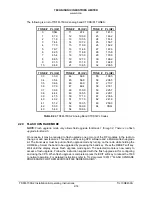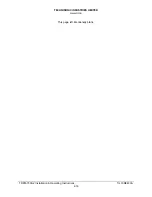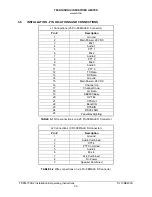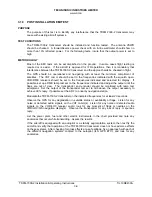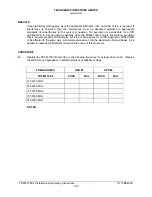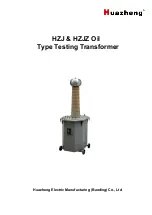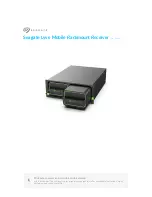
TECHNISONIC INDUSTRIES LIMITED
www.til.ca
TDFM-7300-2 Installation & Operating Instructions
TiL 10RE430A
3-1
SECTION 3 – INSTALLATION INSTRUCTIONS
3.1
GENERAL
This section contains information and instructions for the correct installation of the TDFM-7300-2
Transceiver.
3.2
EQUIPMENT PACKING LOG
Unpack the equipment and check for any damage that may have occurred during transit. Save
the original shipping container for returns due to damage or warranty claims. Check that each
item on the packing slip has been shipped in the container.
3.3
TRANSCEIVER INSTALLATION
The TDFM-7300-2 Transceiver is designed to be Dzus mounted and should be installed in
conjunction with an IN-7300 installation kit. See Figure 3-1 for an outline drawing of the unit with
dimensions to facilitate the installation.
3.4
INSTALLATION KIT - CONTENTS
The IN-7300 installation kit (P/N 069726-1) consists of:
1.
One 25 pin Cannon D mating connector (female) complete with crimp pins and hood.
2.
One 9 pin Cannon D mating connector (female) complete with crimp pins and hood.
3.
One 15 pin Cannon high density D connector (female) complete with crimp pins and
hood.
4.
Five (5) BNC connectors.
3.5
ANTENNA INSTALLATION
The type and number of antennas depends on the model of transceiver being installed. The
following is a list of recommended antennas for the various RF modules:
VHF
136 to 174 MHz Comant part # CI-292
UHFLO
403 to 470 MHz Comant part # CI-275
UHFHI
450 to 512 MHz Comant part # CI-275
UHFHI (II)
450 to 520 MHz Comant part # CI-285
800
806 to 870 MHz Comant part # CI-306
800/700 (II)
700 to 870 MHz Comant part # CI-285
Type II (II) modules have a wider bandwidth in some cases. If communications are going to occur
in this wider bandwidth area, the antenna with wider coverage should be used.
The antenna should be mounted on the bottom of the aircraft whenever possible possible and
must
not be co-located (kept at a separation distance of more than 20cm from each other when
installed)
.
Also they must be installed in such a way that they always maintain a separation distance of
more than 90cm
(36 inches)
from any
from any occupant in the airframe
during operation.
Consult
with instructions provided with the antenna. Connect the RF cables to the back of the transceiver
using the BNC connectors provided in the installation kit. It is possible to use equivalent 50-ohm
aviation antennas that cover the appropriate bandwidths. For IFR certified aircraft, it is
recommended to use the Sensor Systems antenna for VHF low band along with a low pass filter
to prevent harmonic interference with NAV equipment.












